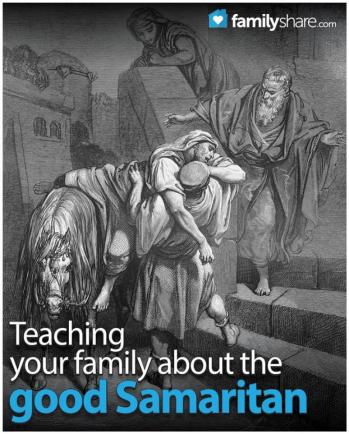
As my youngest son and I were making our way to our gate at the airport, we heard an airline employee calling after an elderly man. He was heading into the women's restroom. The employee could not leave his position, and the man could not hear him. Although I was loaded down with several bags and trying to shepherd my son to the waiting area, I quickly changed course and reached the man. Patting him on the shoulder, I let him know he was heading the wrong way. He thanked me and turned around. When we reached our gate and sat down, the employee smiled and thanked me for helping.
Performing such acts of kindness has become synonymous with being a "good Samaritan,"� in reference to the parable told by Jesus in Luke 10. Perhaps one of the most retold of Christ's parables, the main character truly exemplifies the teaching of Christ that when "ye have done it unto one of the least of these my brethren, ye have done it unto me."� (Matthew 25:40) When we act as a good Samaritan, we are acting as Christ would act. Therefore, teaching and following this parable should be integral in teaching our families.
Read and study
First, you must take the time to read this parable to your family. Help them understand who the characters are and what they represent. Also, don't forget to put it in the context in which it is told. The lawyer who prompts the telling of this parable plays an important role in the lesson to be learned. For younger children, it might be helpful to view a video portrayal of the parable.
Ask questions and gain insights
After reading the parable of the good Samaritan, get feedback from your family as to what insights they have. For example, ask who are our neighbors? Help them understand that our neighbors are everyone we come in contact with, not just those who live near us.
When the lawyer asks who his neighbor is, he is trying to justify his own way of life. Have your family think about ways in which they might try to justify not loving their neighbors. Then, discuss how you can overcome those justifications.
Discuss how it was not convenient for the Samaritan to help the man who fell among thieves. Serving others is not always convenient or even in your comfort zone.
When we had a lesson on this parable in our home, my husband pointed out that the Samaritan wasn't just someone who went out of his way to help, but was someone you wouldn't expect to go out of his way to help. Look for other types of insights that might help your family come to a greater understanding of the parable.
Apply what you learn
Reading, studying and discussing are all good, but none of these will help you to become true disciples of Christ. So you need to take what you learn and apply it to your life. Whenever you see a need, try to fill it. Just as I helped the elderly man, go out of your way to help others. These acts of service may be big or small, to rich or poor, close to home or far away. All that matters is that you act as Christ would act.
The scriptures are full of lessons that will help you along the path of life. When you take the time to study, learn and apply each of these lessons you will find that you have become more and more like Christ in word and deed.

